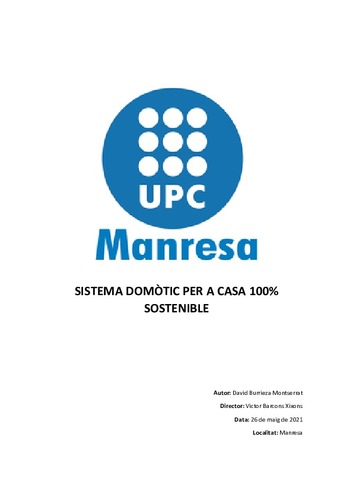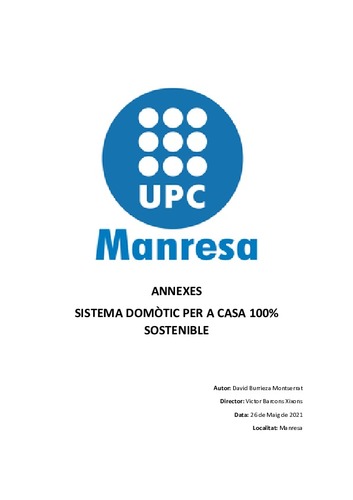Mostra el registre d'ítem simple
Sistema domòtic per a casa 100% sostenible
| dc.contributor | Barcons Xixons, Víctor |
| dc.contributor.author | Burrieza Montserrat, David |
| dc.contributor.other | Universitat Politècnica de Catalunya. Departament d'Enginyeria Minera, Industrial i TIC |
| dc.date.accessioned | 2021-11-10T11:00:19Z |
| dc.date.available | 2021-11-10T11:00:19Z |
| dc.date.issued | 2021-06-22 |
| dc.identifier.uri | http://hdl.handle.net/2117/355953 |
| dc.description.abstract | Es vol desenvolupar en aquest projecte el disseny d’una casa domòtica sostenible. Primerament hem de tenir en compte l’automatització domòtica que hem d’implementar per a aconseguir la comoditat que ens ha d’oferir aquesta. Això ho farem mitjançant diversos microcontroladors i relés si hi son necessaris, que controlaran algunes càrregues controlables de l’habitatge com la il·luminació o la seguretat, aconseguint així un estalvi energètic que aprofitarem alhora que una comoditat millorada per als habitants d’aquest. Farem diferents aplicacions reals per a la comprovació física d’aquestes idees com l’automatització de persianes, el control de la il·luminació, l’alarma i un sistema de connexió i desconnexió de càrregues depenent de la seva prioritat en l’habitatge tenint en compte la nostra generació d’energia en vers al consum. Tot això amb un sistema modular i inalàmbric de forma que es podria aconseguir una implementació immediata a un habitatge real. Es necessita també fer un disseny d’un sistema fotovoltaic realitzant l’estudi necessari per a comprovar quantes plaques necessitarem per a abastir el consum realitzat tenint en compte tots els aparells de la casa i les diferents èpoques de l’any on generarem i consumirem més o menys energia. Alhora s’ha de tenir en compte la connexió a xarxa perquè es possible que l’energia generada no sigui suficient per al consum demanat, farem doncs el disseny de la nostra instal·lació elèctrica amb tots els components necessaris per a la correcta automatització i control de la casa amb l’objectiu de reduir al mínim el consum i alhora l’estalvi tant energètic com econòmic. Parlarem alhora dels components necessaris per a aquesta instal·lació elèctrica explicant cada part al detall com per exemple els interruptors de cada tipus i la seva funció dins del quadre elèctric, els elements necessaris per a convertir l’energia generada per les plaques fins arribar a la nostra xarxa de consum tenint en compte el consum a partir d’un sensor de corrent que connectarem a un arduino que controlarà aquestes càrregues depenent la seva prioritat. |
| dc.description.abstract | This project aims to develop the design of a sustainable automated house. We must first consider the automation part that we need to implement to achieve the comfort that it has to offer us. We will do this by using various microcontrollers and relays, if necessary, which will control some controllable loads in the house such as lighting or security, thus achieving energy savings that we will take advantage of while improving comfort for its inhabitants. We will make different real applications for the physical verification of these ideas like the automation of blinds, the control of the lighting, the alarm, and a system of connection and disconnection of loads depending on his priority in the house, taking at the same time into account our energy generation towards consumption. All this with a modular and wireless system so that an immediate implementation could be done in a real home. It is also necessary to make a design of a photovoltaic system doing a previous study to check how many plates we will need to use to supply the consumption made, taking into account all the appliances in the house and the different times of the year where we will generate and consume more or less energy. At the same time, the network connection must be taken into account because it is possible that the energy generated is not enough for the requested consumption, so we will design our electrical installation with all the necessary components for the correct automation and control of the house to minimize consumption and at the same time saving both energy and money. We will talk at the same time about the components needed for this electrical installation explaining each part in detail such as the switches of each type and their function within the electrical panel, the elements needed to convert the energy generated by the plates to reach our consumption network taking into account the consumption from a current sensor that we will connect to an Arduino that will control these loads depending on its priority. |
| dc.language.iso | cat |
| dc.publisher | Universitat Politècnica de Catalunya |
| dc.rights | Attribution-NonCommercial-NoDerivs 3.0 Spain |
| dc.rights.uri | http://creativecommons.org/licenses/by-nc-nd/3.0/es/ |
| dc.subject | Àrees temàtiques de la UPC::Energies::Energia solar fotovoltaica |
| dc.subject | Àrees temàtiques de la UPC::Informàtica::Automàtica i control |
| dc.subject.lcsh | Home automation |
| dc.subject.lcsh | Ecological houses |
| dc.subject.lcsh | Photovoltaic power systems -- Automatic control |
| dc.subject.other | Domòtica |
| dc.subject.other | sostenibilitat. |
| dc.title | Sistema domòtic per a casa 100% sostenible |
| dc.type | Bachelor thesis |
| dc.subject.lemac | Domòtica |
| dc.subject.lemac | Cases ecològiques |
| dc.subject.lemac | Instal·lacions fotovoltaiques -- Control automàtic |
| dc.identifier.slug | PRISMA-160359 |
| dc.rights.access | Open Access |
| dc.date.updated | 2021-07-28T18:32:25Z |
| dc.audience.educationlevel | Grau |
| dc.audience.mediator | Escola Politècnica Superior d'Enginyeria de Manresa |
| dc.audience.degree | GRAU EN ENGINYERIA ELECTRÒNICA INDUSTRIAL I AUTOMÀTICA (Pla 2016) |



